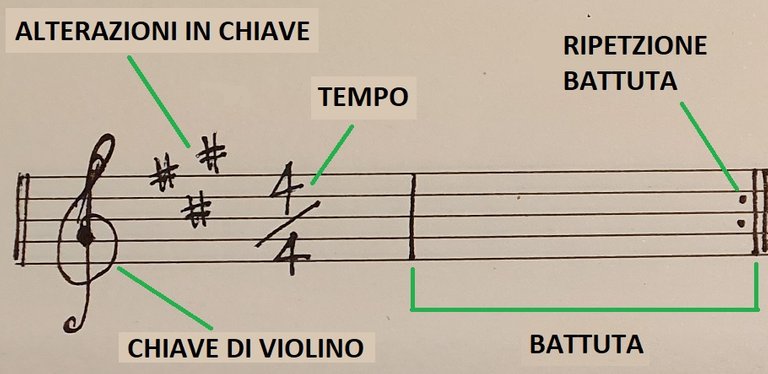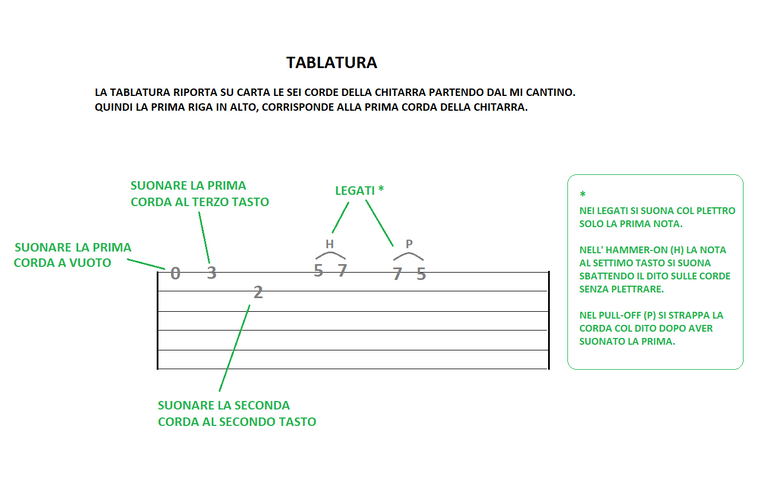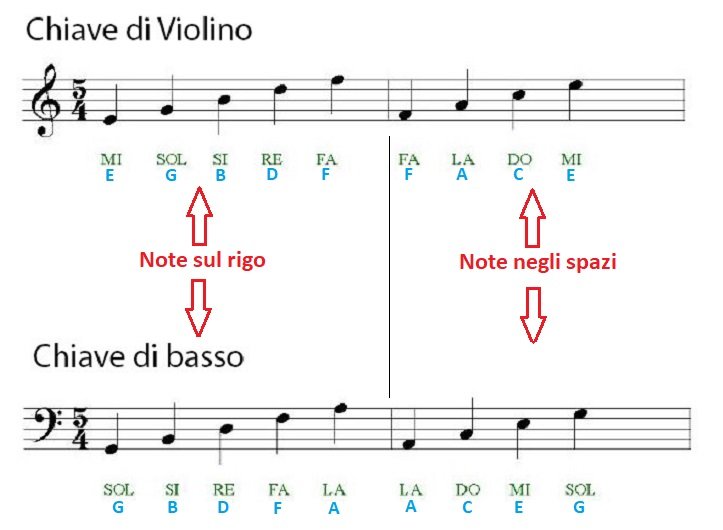Fundamentals of musical notation.
Good morning, my friends Steemians and welcome back! Today we begin a music lesson, basic concepts that are the foundations of musical writing and reading. You are ready? Here we go!
Musical notation is a complete and self-sufficient systematic method of writing which allows music to be transmitted without direct listening. Many authoritative players do not know it and it is a real pity, not so much because knowing it they could give more, but because this fact leads beginners to believe that knowing musical writing is not worth it.
Learning musical notation is important in some aspects: firstly, you can retrieve a score of a song and start playing it without ever having heard it (like reading a new book for instance), in secundis you can transcribe your every musical idea and materialize it in front of you, and lastly, you can communicate with other musicians even without playing, but above all you can easily understand the structure of the scales, chords, melodies, harmony and rhythm.
For the guitar we will use two musical notations: the classic in pentagram with notes and fingering, the most modern and effective tablature. The choice of which method to use is up to you.
The basic musical notations are relatively simple but obviously they require time and practice to be assimilated.
Reading a score at first sight is not something you learn in a single day.
We will begin by saying that the notes follow one another on a grid with five horizontal lines called a pentagram.
The vertical positioning of the notes determines the octave. The higher the note, the more it will be written in its top row or space.
The notes in the spaces are FA DO DO MI, the notes on the staves are MI SOL SI RE FA.
At the beginning of the pentagram, a symbol determines the key: treble clef (or SOL, because it starts from the SOL line), or bass clef. We will limit ourselves to the treble clef that is what we need, then for knowledge I will treat the bass clef very superficially.

In modern music it is mandatory to learn the Anglo-Saxon notation of notes as it is the most used:
DO = C, RE = D, MI = E, FA = F, SOL = G, LA = A, SI = B
Learn them by heart!
After the treble clef we could find symbols, they determine its tonality. The symbols are Diesis (#) and Bemolle (b).
Immediately after the notation in key, we will find two numbers arranged as a fraction, that is the beat time.
The tablature (abbreviated as TAB) is a musical writing system used for string and key instruments.
The method is to write indicating the fingerings to be used for the entire piece in a stenographic way.
In the case of the guitar, instead of the pentagram, the six strings, the keys to press them, the fingering to use and the time to hold are shown. It is much easier to learn and read but does not give us precise information on the harmonic structure.

For notation in bass key, simply lower the musical note by one line and one space, as in the example below.

Well friends, this first basic music lesson is over, I hope you have been useful and soon with the second lesson!
Bye!
Fondamentali della notazione musicale.
Buongiorno amici Steemians e ben ritrovati! Oggi cominciamo una lezione di musica, concetti basilari che stanno alle fondamenta della scrittura e lettura musicale. Siete pronti? Andiamo!
La notazione musicale è un metodo sistematico di scrittura completo ed autosufficiente il quale permette di trasmettere la musica in assenza di un ascolto diretto. Molti autorevoli suonatori non la conoscono ed è un vero peccato, non tanto perchè conoscendola potrebbero dare di più, ma perchè questo fatto induce i principianti che ritenere che conoscere la scrittura musicale non ne valga la pena.
Imparare la notazione musicale è importante per alcuni aspetti: in primis, potete recuperare uno spartito di un brano e cominciare a suonarlo senza mai averlo sentito (come leggere un nuovo libro per intenderci), in secundis potete trascrivere ogni vostra idea musicale e materializzarla davanti a voi, e per ultimo potete comunicare con altri musicisti anche senza suonare ma soprattutto potete capire facilmente la struttura delle scale, degli accordi, delle melodie, dell'armonia e del ritmo.
Per la chitarra utilizzeremo due notazioni musicali: la classica in pentagramma con le note e la diteggiatura, la più moderna ed efficace intavolatura. A voi la scelta di quale metodo utilizzare.
Le basilari notazioni musicali sono relativamente semplici ma ovviamente richiedono tempo ed esercizio per essere assimilate.
La lettura di uno spartito a prima vista non è una cosa che si impara in un solo giorno.
Cominceremo col dire che le note si susseguono su una griglia a cinque righi orizzontali chiamata pentagramma.
Il posizionamento verticale delle note, ne determina l'ottava. Più la nota è alta, più andrà scritta nel suo rigo o spazio in alto.
Le note negli spazi sono FA LA DO MI, le note sui righi sono MI SOL SI RE FA.
All'inizio del pentagramma, una simbolo ne determina la chiave: chiave di violino (o di SOL, perchè parte dal rigo del SOL), oppure chiave di basso. Ci limiteremo alla chiave di violino che è quella che ci serve, poi per conoscenza tratterò molto superficialmente la chiave di basso.

Nella musica moderna è obbligatorio imparare la notazione anglosassone delle note in quanto è la più utilizzata:
DO=C , RE=D , MI=E , FA=F , SOL=G , LA=A , SI=B
Imparatele a memoria!
Dopo la chiave di violino potremmo trovare dei simboli, essi ne determinano la tonalità. SOno i simboli di Diesis (#) e Bemolle (b).
Subito dopo la notazione in chiave, troveremo due numeri disposti come una frazione, quello è il tempo delle battute.
L'intavolatura (abbreviata con la dicitura TAB) è un sistema di scrittura musicale utilizzato per gli strumenti a corde ed a tasti.
Il metodo è quello di scrivere indicando le diteggiature da usare per l'intero brano in modo stenografico.
Nel caso della chitarra, al posto del pentagramma, vengono riportate le sei corde, i tasti dove premerle, la diteggiatura da usare ed il tempo da tenere. E' molto più semplice da imparare e leggere ma non ci fornisce informazioni precise sulla struttura armonica.

Per la notazione in chiave di basso, semplicemente basta abbassare di un rigo e di uno spazio la nota musicale, come nell'esempio qui sotto.

Bene amici, questa prima lezione di musica base è terminata, spero vi sia stata utile ed a presto con la seconda lezione!
Ciao!
Immagini ed esercizi dell'autore.
Fondamentalmente ti meriti un...
@tipu curate
Upvoted 👌 (Mana: 10/15 - need recharge?)
Grazie
Your post has been supported and upvoted from the Classical Music community on Steemit as it appears to be of interest to our community. We also support jazz and folk music posts!
If you enjoy our support of the #classical-music community, please consider a small upvote to help grow the support account!
You can find details about us below.
The classical music community at #classical-music and Discord. Follow our community accounts @classical-music and @classical-radio or follow our curation trail (classical-radio) at SteemAuto!
Delegation links: 10SP, 25SP, 50SP, 75SP, 100SP, 150SP, 200SP, 250SP, 500SP, 1000SP
eccellente quello che hai scritto....vorrei dirti una cosa e spero di farmi capire perchè difficile da dire...secondo me quando si scrive un testo musicale, è come se si facesse un tema...per farlo in modo corretto devo conoscere grammatica e sintassi...per decretarne la paternità dovrei avere una stilistica che fa capire ad occhi chiusi, senza leggere nome e cognome, che il pezzo è mio....non mi riesce con tutti i musicisti ma ne riconosco parecchi ad occhi chiusi, quelli di cui conosco più brani ma che in me hanno impresso la loro firma...è bellissimo
Hai perfettamente reso l'idea. Concordo in pieno!
tutto eccellente a mio avviso...bravo cosi ti potranno seguire in tanti....sai che adoro il bemolle?....a mio avviso renderebbe interessante dal punto di vista dell'ascolto qualsiasi composizione....mi assomiglia a un congiuntivo in un tema d'italiano!!!
A me piace molto la tonalità in Si bemolle.... fin da bambino ero attratto dalla sua sonorità